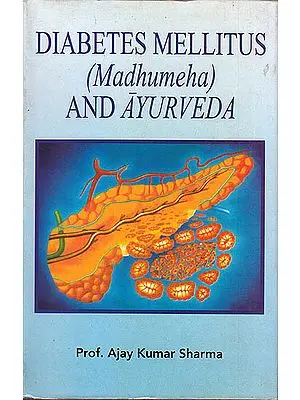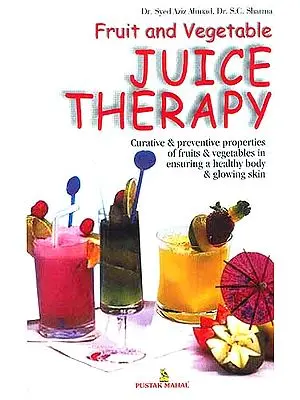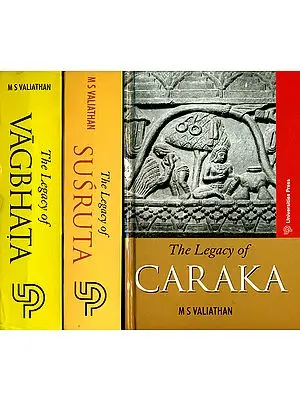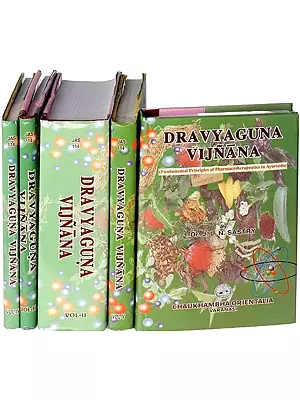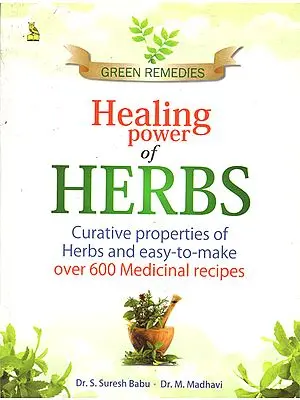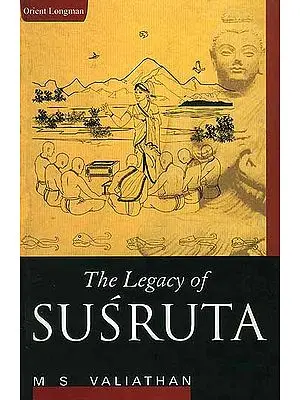Diabetes Ayurvedic Herbal Palliative Therapy
| Item Code: | IDI683 |
| Author: | K. Nishteswar |
| Publisher: | Chowkhamba Sanskrit Series Office |
| Edition: | 2006 |
| ISBN: | 8170802083 |
| Pages: | 318 (Color Illus: 17) |
| Cover: | Hardcover |
| Other Details | 8.7" X 5.4 |
| Weight | 400 gm |
Preface
Diabetes is a common endocrinal disorder, now identified as a metabolic syndrome, affecting over 100 million people worldwide. The World Health Organisation and International Diabetes Federation have predicted an epidemic of Diabetes in India by the year 2025. The prevalence of Type II Diabetes or NIDDM is growing at a very fast rate in urban and semi-urban population.
Diabetes mellitus is a condition characterized by chronic elevation of blood glucose levels. Many patients are asymptomatic and Glycosuria is noticed on a routine medical check-up Tiresomeness and weight loss are common in this condition. Patients may complain of thirst, polydipsia, polyuria and nocturia related to a glucose induced osmotic diuresis. Pruritus vulvae and balanitis are related to candidial infections of the genitalia. Visual disturbance is caused by a temporary lens malfunction. Pain and parasthaesia in the limbs may be present, caused by a painful neuropathy. A strong genetic component is invariably found in Type 1 diabetes and visceral obesity is associated with Type 2 diabetes. In recent researches it was found that individual shaving Acanthosis nigricans (a skin manifestation) are more prone to get diabetes. Good control of diabetes always involves die, exercise and drugs. The aim of the treatment is to keep the blood sugar level within the normal range throughout the 24 hours to avoid ketosis, infections and other long-term complications. Every patient must be assessed individually.
The disease Madhumeha one of the varieties of Prameha enumerated in Ayurvedic classics is interpreted as Diabetes Mellitus, and some of the salient observations made by Acharyas of Ayurveda are as Follows:
1. Prameha is designated as Anusangi Vyadhi i.e., diseases that reoccurs frequently. This observation of Charaka indicates that diabetes which is included under Prameha is an incurable condition.
2. Acharya Charaka must be credited for providing a distinct diabetic descriptive profile for the first time in the medical literature world. Charaka's diabetic profiles include Mandotaham (less enthusiasm), Atisthoulyam (obesity), Atisnigdham (over unctuous) and Mahashanam (Gluttony). Charak has emphasized that voracious eaters who develop aversion to bath and physical exercises are more prone for Prameha.
3. Charaka has also documented cases of diabetes of congenital (Jaatahaprameha) as well as hereditary (Kulaja) is origin. He also put forth his view that all the other hereditary ailments are incurable.
4. Sushruta has identified two varieties of Prameha i. e., Sahaja (inherited or hereditary) who appears like emaciated (Krisha) and Apathyanimittaja (acquired) who are usually obese (sthoulya). Patients suffering from Prameha are classified by Charaka also into two categories, viz., (a) those who are obese and strong and (b) those who are emaciated and weak.
5. Sushruta laid down the criteria for diagnosing Madhumeha as follows: "All patients of Prameha suffering from boils and other complications acquire sweetness in urine etc. whose odour is akin to that of honey should be considered as Madhumehi. By this definition it can be inferred that Madhumeha as Diabetes Mellitus with complications and Kshaudrameha could be diabetes without any complications.
6. Sushruta suggested various types of exercise for the management of Prameha and the details are - The patients who are poor and are without relatives should walk a hundred yojana (one yojana = 8-9 miles / 12-14 km.) or more without shoes and umbrells, living on alms, staying overnight only in each village and should be self-controlled like an ascetic. The rich patient should live amongst the deer and subsist on the grins of syamaka and nivara and the fruits of Amalaki, kapittha, tinduka and asmantaka. He should constantly follow the cows and take their faeces and urine. A Brahmin patient should live on sila vritti or uncha vritti (live only on the fallen grains from plants/ grains fallen on the floor during cleaning at home) and the recite the Veda. The farmers should constantly be engaged in farming and digging of wells. The thin patients should always be protected.
7. After a thorough scan of treatment profiles of Prameha suggested by Charaka and Sushruta, the sage compiler Acharya Vagbhata has formulated the dual combination of Dhatri and Haridra for Prameha in general and Shilajit in particular for Madhumeha.
8. During last three decades, considerable research work has been carried out on antidiabetic potential of various plant species, significant antidiabetic ativity of Momordica charantia, Coccinia indica, Swertia chirata, Gymnema sylvestre, Pterocarpus marsupium, Allium cepa, Allium sativum, Ocimum sanctum, Syzygium cumini (Eugenia jambolana), Mucuna pruriens, Tinospora cordifolia, Murraya koenigii, Trigonella foenum-graecum, Aloe vera, Cajanas cajan etc. have been reported. In this book efforts have been made to summarize the recent research reports of various plant species showing antidiabetic activity.
9. Research so far carried out with Ayurvedic drugs indicate that several herbs mentioned for the treatment of Madhumeha have shown significant hypoglycaemic actions in both experimental as well as clinical studies. The herb Bijasara (Pterocarpus marsupium) has the potentiality to regenerate damaged cells of pancreas. Gudmar (Gyimema stimulate) and Jambu (S. cumini) have shown to stimulate the insulin secretion (Insulinotropic activity). In the radio-immuno assay the drugs like Patraka (C. tamala) and Pushkarmoola (I. racemosa) have exhibited insulinotropic actions. Clinical studies with Chandraprabhavati have shown better glycemic control. Ayurvedic metallic formulations like Vasanta kusumakar are found be useful in certain diabetic complications with a nephroprotective action. The combination of Aswagandha with Saptamrita loha is very useful to prevent diabetic retinopathy and cataract formation. In a research study to understand the factors responsible for the potent antioxidant and radioprotecting ability of triphala, it has been evaluated for radical scavenging ability, xanthine oxidase inhibitory activity and phytochemical (phenolics) content. When triphala was tested for super oxide radical scavenging activity using xanthine and xanthine oxidase assay, it was observed that in addition to reacting with superoxide radical, it also inhibited uric acid formation, indicative of xanthine oxidase enzyme inhibitory activity. It was concluded that triphala is having potent antioxidant and radioprotecting ability. In Ayurvedic Classics triphala is attributed with eye protecting action (Chakshushya) and it can be used to prevent cataract formation in diabetics.
10. Three Yogasanas (Dhanurasana, Matsyendrasana and Bhujangasana followed by Shavasana) practised by diabetes patient not only help to utilize the peripheral glucose in the body but also help to stimulate the pancreas to excrete the insulin.
11. In recent researches it was found that use of sunflower oil increases the risk of getting diabetes and Ischaemic heart diseases so one should give up using sunflower or safflower oil o prevent diabetes and heart diseases.
12. Free radicals are responsible for producing many changes in cellular function in very different ways. They interfere with multi enzyme systems and thus disturb metabolism at cell, tissue or organ level. For example, inflammatory or degenerative changes in the pancreas lead to production of free radicals that destroy acinar cells and beta cells of islet of Langerhans. Free radical injury is an important component in the pathophysiology of diabetes mellitus. The combination of Amalaki (Indian Goosberry) and Haridra (Turmeric) has potential applications for many aspects of the pathology of diabetes. In Type I (Insulin dependent) diabetes, destruction of pancreatic b-cells causes loss of insulin secretion, whereas in Type 2 (non insulin dependent) diabetes, insulin resistance of peripheral tissue is the major problem. The combination of Amalaki and Haridra has potential preventive or ameliorative affects in both type 1 and 2 diabetes.
13. Many of the complications induced by diabetes, including polyneuropathy and cataract formation appear to be mediated by free radical generation. Another common complication of diabetes is cataract formation. Oxidative stress leading to oxidative changes in the lens membrane and lens proteins has been implicated in the opacities associated with lens cataract. Increased levels of free radicals occurring during non-enzymatic glycation cause an oxidative stress to the lens. A number of studies have suggested that oxidative process are involved in cataractogenesis. The oxidative stress may be common to cataracts caused by a number of different agents. Aswagandha (Withania womnifera) which is having adoptogenic activity has been reported by the team of scientists of L. V. Prasad Eye Institute, Hyderabad that it helps in retarding cataract formation. (The Hindu, Oct 17 2005) Aswagandha also plays an important role in the management of diabetic Impotence.
14. The NIDDM epidemic is a manifestation of globalisation. Zimmet termed the process Cocacolanization and called diabetes a "Western killer let loose in paradise." The incidence of diabetes increases with obesity which is becoming much more prevalent in urban areas. Zimmet observed that a decrease in average weight by 10 kg. Might decrease diabetes deaths by 50%. The Ayurvedic drugs namely Guggulu (Commiphora mukul), Shilajit (Bitumen), Musta (Cyperus rotundus) and Daruharidra (Berberis aristata) are found to be useful in controlling obesity.
15. Betel-nut Villain of Increased Glycaemia in British Asians: Area Asians as a group more genetically prone to diabetes or is it a lifestyle factor that needs to be changed? This was a question that addressed by Mannan et al, at the Academic Medical Unit, St Bartholomew's and the Royal London School of Medicine and Dentistry, Queen Mary, Westfield College, U. K. It is a known fact that many, nitrosamines are diaetogenic, causing both type 2 and type 1 diabetes. Quite specifically, it appears that beetle chewing a habit common to about 10% of the world's population (more than 200 million people) may be an important factor contributing to the risk of developing type 2 diabetes mellitus. In animal studies in CDI mice, it has been seen that when mice are fed with betel-nut or associated nitrosamines, 8.5% develop glucose intolerance with marked obesity. Based on these observations, Mannan et al, decided to investigate on Asian population which routinely consumed betel-nut. Banglaeship of whom 12% were known to have diabetes. A further 145 to 187 subjects 'at-risk' of diabetes (spot glucose>6.5 mmol/1<2h after food, or >4.5 mmo/1>2h after food) had a second blood glucose sample taken; sixty-one were confirmed as 'at-risk' and had an oral glucose tolerance test; nine new diabetics were identified. But in Ayurvedic classics sage Sushruta advocated the combination of Khadira (Acacia catechu) and Kramuka (Betel nut) for the management of Kshoudra Meha (uncomplicated diabetes). So, betel nut helps in controlling diabetes.
Considering the interest being evinced by the public as well as the practitioners of alternative systems like Allopathy, Homeopathy and Unani to know about ayurvedic anti-diabetic herbal and herbomineral formulations an attempt is made in this book to compile the useful information relevant to the management of diabetes. The disease profiles of diabetes, Ayurvedic treatment with herbal and herbo-mineral drugs, research profiles about ayurvedic herbs along with the different prescriptions of reputed and experienced ayurvedic physicians are enumerated in this monograph. Hope the information furnished in this book will be useful to the Students, Research Scholars and Practitioners of Ayurveda. I express my sincere thanks to all the Scientists, whose work has been taken up for reviewing the research studies carried out on Ayurvedic Drugs. I also express my indebtness to Dr. K. Raghunathan, Ex-Deputy Director, Central Council for Research in Ayurved & Siddha, New Delhi and Late Dr. S. Venkata Raghavan, Ex. Asst. Director, Central Council for Research in Ayurved & Siddha, New Delhi for their ablest guidance in the preparation of this monograph. I acknowledge M/s. Chaukhamba Sanskrit Series Office, Varanasi for publishing this book.
Back of The Book
'Sahasrayogam' is enjoying the status of Ayurvedic Practical Prescriber among Kerala Ayurvedic Physicians. The public of Kerala also Keeps this book with them and considers it as the book of Ayurvedic Home Remedies. 'Sahasrayogam' means one thousand formulations, and on a rough estimate it appears that the number of formulations vary from 700 to 1200 in various versions. It also appears that some more formulations have been added periodically to the original text based on their practical experiences, which resulted in the increase of total number of formulations. The formulations described in the book consist of different Kalpanas like Kashaya (Decoction), Taila (Medicated oil), Ghrita (Medicated Ghee), Choorna (Powder), Asava, Arishta (Fermented liquid), Vati, Gutika (Pill) and Lehya (Linctus). Besides the poly herbal formulations, single drug recipes are also indicated for the treatment of different diseases. In addition to the classical formulations some of the traditionally useful simple herbal recipes are also included in this book.
Sahasrayogam was originally written in Sanskrit language and translated into Malayalam. Some of the slokas in the text consist of Malayalam vernacular names of the descriptions of certain herbs. A good number of Kashaya (Decoction) yogas was incorporated into other Kalpanas. Even today a large section of patient population of Kerala regularly consumes more number of Kashayas. It is customary in Kerala that one has to study thoroughly Ashtanga Hridaya initially, followed by Sahasra-yogam to practice Ayurveda. It is quite apt to assert that Ashtangahridaya and Sahasrayoga are the two eyes to Kerala Ayurvedic physicians.
The description of different formulations facilitates the pharmacist as well as physician to prepare the formulation without difficulty. This book will be useful not only to the practitioners of Ayurveda but also to the under graduate as well as Post-graduate student community of Ayurvedic Medicine.
India has been projected by the W.H.O. as the country with the fastest growing population of Diabetics. Diabetes mellitus is a syndrome with disordered metabolism and inappropriate hy- perglycemia due to either a deficiency of insulin secretionr to a combination of insulin resistance and inadequate insulin secre- tion to compensate. The WHO system of classification contains three major clinical classes: Diabetes mellitus, impaired glucose tolerance, and gestational diabetes mellitus. International com- mittee of experts in the field suggested several changes in the classification of diabetes mellitus and recommended finally Type 1 and Type 2 diabetes and eliminated the term Insulin depen- dant mellitus (IDDM) and non-insulin dependent diabetes mel- litus (NIDDM) since they are based on pharmacological rather than causative considerations. Type 1 diabetes is due to b cell islet destruction by autoimmune process, and these patients are prone to Ketoacidosis. Type 2 diabetes is the more prevalent form and results from insulin resistance, mainly caused by vis- ceral obesity, with a defect in compensatory insulin secretion.
Diabetes mellitus is a clinical syndrome characterised mainly by polyuria, polydipsia and polyphagia. This disease has been known since ages and the sweetness of diabetic urine has been mentioned in Ayurveda among the varieties of Prameha disease. Ayurvedic classics also describe genetic manifestation of this disease and categorise such individuals as JATA PRAMEHI.' The Diabetic Profiles described by Charaka also include obesity, excessive eating, sedentary life and excessive intake of fatty sub- stances.
Man is relentlessly striving hard ab initio to find out new and specific remedies in order to combat diseases. Primeval man has also practiced therapeutics by diagnosing different diseases but his indulgence in the application of superstition for the elu- cidation of etiology or specific treatment failed to evolve rational therapeutics. Ayurveda is the first science in the history of medi- cine, which attempted to rationalise therapeutics.
A careful and critical study of Patho-physiology of Prameha reveals one fact beyond doubt that medas is an important dushya of this disease. The etiology of Medoroga described by Acharyas is almost the same as described for Prameha. Atisthula and Atikrisha are prone to a number of diseases. Of these two, Atisthula has got a greater disadvantage that he is not only prone to a number of diseases but the diseases he is going to get are difficult to cure. It is particularly so when he gets diseases involv- ing dhatukshaya requiring santarpana measures as such mea- sures are likely to increase sthoulya. Hence the provfrbial saying that "Karshya meva varam sthoulyat nahi sthulasya beshajam." Prameha is one such disease that atisthulas are prone to get. The patients of Prameha have been classified into two groups i.e. sthula (Obese) and Krisha (Emaciated). The Abaddha Medas and Meda-kleda play the vital role in the genesis of Prameha. All these descriptions explicitly convey the involvement of inborn metabolic derangements in Prameha disorder. So treatment should be planned keeping the impairment of Dhatwagni- vyapara in view. Constitution also plays a major role in the prog- nosis of Prameha in general and madhumeha in particular. So the assessmen t of prakriti helps the clinician in adopting suitable treatment.
Ayurveda has got a very rich therapeutic potentiality. Un- less a correct understanding of the disease described as Prameha in Ayurveda and a disease described as Diabetes mellitus in mod- ern medicine is obtained there is bound to be communication gap. It is not proper to identify Madhumeha alone as Diabetes Mellitus seeing the term madhu, which is madhura. So a Com- prehensive approach of pathogenesis of prameha has been made with a careful review of literature together with different contemporary views expressed by experts in the light of basic principles of Ayurveda.
Important single as well as compound Pramehahara drugs have been enumerated and their pharmaco-therepeutic activity and utility are explained. The approach made as a whole is in strict conformity of classical literature to cater to the needs of Ayurvedists and it can incidentally help to identify some poten- tial hypoglycaemic drugs.
The enumeration made about Rasayana (Anti-oxidant), Vajeekarana (Aphrodisiac) and Medohara (Anti-obesity) drugs may be useful for planning the preventive therapy to avoid de- generative changes in nerves, retina, cerebral and coronary arte- rial vessels. These drugs help to prevent diabetic complications like heart attacks, cerebro-vascular accidents, renal failure, impo- tence, cataract etc.
| 1 | Diabetes Mellitus - Ayurvedic Perspective | 1 |
| 2 | Diabetes Mellitus - Allopathic Perspective | 17 |
| 3 | Ayurvedic Pathogenesis of Diabetes | 38 |
| 4 | Hazards of Allopathic Anti-Diabetic Drugs | 55 |
| 5 | Ayurvedic Anti-Diabetic Herbal and Herbo-Mineral | 61 |
| Preparations-An Overall Preparations of Ayurveda | ||
| 6 | Anti Diabetic Metallic Preparations of Ayurveda | 95 |
| On Unfounded Fears | ||
| 7 | Treatment of Prameha (Diabetes) | 106 |
| Summary | 145 | |
| Annexure | 149 | |
| Bibliography | 279 |




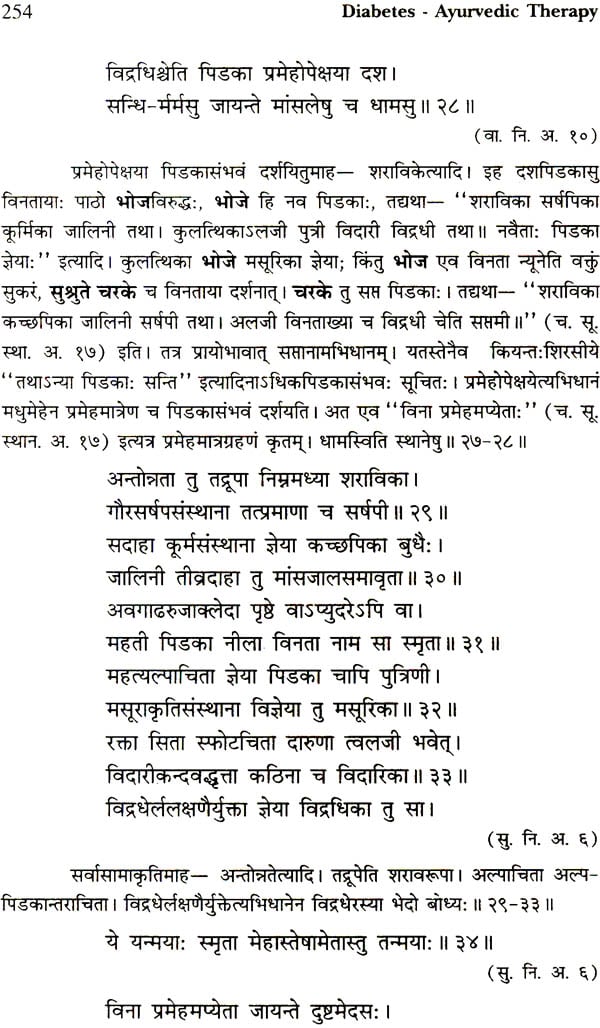

-
Q. What locations do you deliver to ?A. Exotic India delivers orders to all countries having diplomatic relations with India.
-
Q. Do you offer free shipping ?A. Exotic India offers free shipping on all orders of value of $30 USD or more.
-
Q. Can I return the book?A. All returns must be postmarked within seven (7) days of the delivery date. All returned items must be in new and unused condition, with all original tags and labels attached. To know more please view our return policy
-
Q. Do you offer express shipping ?A. Yes, we do have a chargeable express shipping facility available. You can select express shipping while checking out on the website.
-
Q. I accidentally entered wrong delivery address, can I change the address ?A. Delivery addresses can only be changed only incase the order has not been shipped yet. Incase of an address change, you can reach us at help@exoticindia.com
-
Q. How do I track my order ?A. You can track your orders simply entering your order number through here or through your past orders if you are signed in on the website.
-
Q. How can I cancel an order ?A. An order can only be cancelled if it has not been shipped. To cancel an order, kindly reach out to us through help@exoticindia.com.

